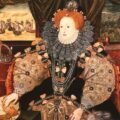
One of Elizabeth I’s main achievements has got to be actually becoming Queen by not only rising above her illegitimacy and the scandal surrounding her mother, Anne Boleyn, but also surviving long enough to actually inherit the throne from her half-sister Mary. Elizabeth life had been in very real danger during Mary I’s reign when her name was linked with Wyatt’s Rebellion, an uprising against Mary I and an attempt to replace her with Elizabeth.
However, the threat to Elizabeth’s life did not end on the day that she became Queen. There were countless plots against Elizabeth I and many of these are listed in a chapter entitled “How Many Plots Were There to Kill Elizabeth I?” in the book that I’m reading at the moment, “How Fat Was Henry VIII? And 101 Other Questions on Royal History”. Another of Elizabeth’s achievements was surviving and having a long and successful reign.
Elizabeth’s life was in constant danger after Pope Pius V issued the Bull Regnans in Excelsis of Excommunication and Deposition against Elizabeth in 1570, which was a green light for Catholics to rise against her and assassinate her. This Bull led to Elizabeth and her government passing strong laws against the Catholics even though Elizabeth had once said that she had “no desire to make windows into men’s souls”.
How Many Plots Were There to Kill Elizabeth I?
In December 1583, Elizabeth I wrote to the French Ambassador:-
“There are more than two hundred men of all ages who, at the instigation of the Jesuits, conspire to kill me.”
and she wasn’t exaggerating!
In October 1583, Elizabeth I’s life was threatened by John Somerville, a Catholic from Warwickshire, who had been stirred up by the anti-Elizabeth I propaganda which the Jesuits were circulating. With the aim of seeing “her head on a pole, for she was a serpent and a viper”, Somerville set out to assassinate his Queen with a pistol. Fortunately, he was arrested, found guilty and sentenced to death before he could kill the Queen. He committed suicide by hanging himself in his prison cell in the Tower of London before his death sentence could be carried out.
Just a year later, Elizabeth I escaped death again when would-be assassin Dr William Parry, a Welsh MP who hid in the Queen’s garden at Richmond Palace, was “so daunted with the majesty of her presence in which he saw the image of her father, King Henry VIII” that he could not murder the Queen. In “How Fat Was Henry VIII?”, Raymond Lamont Brown writes of how it is not known what reason Parry had for his plot to assassinate the Queen, but he was known to William Cecil, Lord Burleigh and worked as a spy, so he claimed that he was acting as a regicide “in order to infiltrate papist circles”. However, he had been heard to boast that he would assassinate Elizabeth if he ever had the opportunity and some believed that he was acting on behalf of Mary, Queen of Scots, with a papal blessing. Parry was sentenced to death and ended his life on the gallows.
The Barge Incident
One of the most famous attempts on Elizabeth’s life was while the Queen was travelling by barge down the River Thames. A shot rang out and one of the Queen’s bargemen collapsed from a bullet wound which was clearly intended for the Queen. As Elizabeth passed him her handkerchief to put on his wound, She said “Be of good cheer, for you will never want. For the bullet was meant for me.”
The Ridolfi Plot
This plot surfaced in 1571 and it aimed to assassinate Elizabeth I and replace her with Mary, Queen of Scots who was to be married to Thomas Howard, 4th Duke of Norfolk.
The plot takes its name from Roberto Ridolfi, a Florentine banker, who was a papal agent, a go-between for the Spanish and the Duke of Norfolk, and the man responsible for funding the rebellion which would see a Northern Catholic rebellion and an invasions by the Spanish under Philip of Spain.
Unfortunately for the Catholics and for the Duke of Norfolk, Elizabeth’s secret service, headed by her spymaster Sir Francis Walsingham, uncovered the plot and it collapsed. The Duke of Norfolk was executed as a traitor in 1572 and Elizabeth never trusted Mary, Queen of Scots ever again.
The Throgmorton Plot
This plot, in 1583, was another attempt to assassinate Elizabeth and replace her with the Catholic Mary, Queen of Scots.
The plot takes its name from Francis Throgmorton, a Catholic who was involved in a number of plots against Elizabeth I. This plot involved Throgmorton acting as a go-between for Mary, Queen of Scots and her agent Thomas Morgan, and the Spanish Ambassador, Don Bernardino de Mendoza. Again, Elizabeth’s secret service got wind of the plot and arrested Throgmorton who, under torture, revealed that the Duke of Guise was planning to invade England from the Spanish Netherlands. As a result of this plot, Throgmorton was executed at Tyburn and Mendoza was thrown out of England and sent back to Spain.
The Babington Plot
The Babington Plot of 1586 was yet another plot which involved Mary, Queen of Scots. The plan was to assassinate Elizabeth, encourage a Catholic rising and put the Catholic Mary, Queen of Scots on the English throne.
This plot is named after Anthony Babington, a man who had worked in Mary, Queen of Scots’s employ as a page. Babington set up a secret society which aimed to help and protect Jesuit infiltrators coming to England to get rid of the heretic Elizabeth I. His society also had links with Mary’s emissaries in Europe who could be called on for aid. The plot had the Pope’s blessing and although it was led by Babington it was actually thought up by John Ballard, a Jesuit priest.
Sir Francis Walsingham, Elizabeth’s spymaster, proved how indispensable he was by uncovering this plot and saving his Queen’s life. Ballard, the Jesuit priest, was arrested and tortured on the rack. He was then executed. Although Babington tried to save his neck by offering information to Elizabeth’s secret service and then fleeing in disguise, he was eventually arrested and was executed as a traitor in September 1586.
This plot was the undoing of Mary, Queen of Scots. She had been implicated in many plots against Elizabeth in the past but this was the last straw. She was beheaded at Fotheringay Castle on the 8th February 1587 after a special court found her guilty of treason.
These are just a few of the plots that Elizabeth survived thanks to God’s protection, luck and the skill of her secret service. Elizabeth more than just survived though, unlike her half-brother and half-sister, she had a long and prosperous reign, ruling the country for over 40 years in a reign known as “The Golden Age”.
Source
The question regarding plots against Elizabeth I is just one of the interesting historical questions examined in “How Fat Was Henry VIII? And 101 Other Questions on Royal History”. This book also examines “Was Amy Robsart, Lady Dudley, murdered by a queen’s Command?” and “Who was the first monarch to install a flushing toilet?”, which both concern Elizabeth I.










Great website & good info about QE1. This is well research & facts are all correct. I love reading about those times in history & recently am doing study on this Queen for some months now.
Thanks for such a good read of all this information.
Mark,
I think Elizabeth was very clever I am not sure if she plotted against her brother and sister when they were on the throne but to survive I bet she spied on them I am glad she got the throne But I think she should have married
The Jesuits were not “circulating lies” as is maintained. This was Elizabethan propaganda against them. There were no more than two–maybe only one–Jesuits in England in 1583. They were there, as were other priests, to minister to the other Catholics. Since denying the national religion was considered a denial of the temporal power in post-Reformation Europe, they were declared traitors. But mostly they were not.
Elizabeth I was the greatest monarch in English history. I’ve learned much about her and admire her greatly. If the Bishop of Rome hand not excommunicated her there would have been little flashback against Romanists in her England. The fault with Mary of Scotland death is squarely on her own head for conspiring to displace Elizabeth her protector. Before the flack starts I use the term “Romanists” to describe those Catholics who maintained loyalty to the BoR as opposed to the the CoE.
What of the assasination attempt wherein the pistol was not loaded properly as portrayed in the movie with Cate Blanchett as the queen?
Hi Claire Ridgway,
I am writing a screenplay on EQ1, this page was that extra bit helpful.
Thank you very much.
Ginny Monroe MA
Which was the most serious plots and why?
Have visited all the locatons in Scotland were all these events occurred her research is impeccable. Antonia Fraser’s “ Mary Queen of Scot’s”all the locations were accurate. Discribed to a Point of pointing out the blood on the floor in her chamber where Lord Riccio was stab.What never mentioned Mary had her revenge in death. Elizbeth had no children. Mary had James1. Upon Elizbeth death Mary Son assented to the throne of Scotland and England . He then transfers his mother body and was entomed in Westminster Abby right behind her sister Elizbeth tomb. It was interesting as a yank I visted Mestmindter and one of the guides did know where Mary’s tomb was. Being a retired Detective (NYPD) I was not leaving until I founded it. I am also a history buff. I need to Thank Antonia Fraser for peeking my interest. Saw the locations confirmed everything in her book. Saw both the tombs in Westminster . Thanks
Add comment Elizbeth and Mary never met in real life. Índole if some movies to contest.
Add comment Elizbeth and Mary never met in real life. Ínspit if some movies to contray. Right I just love the history ..England my English cousins !!!!